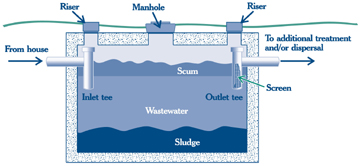

MENU
Get To Know Your Septic System!
Ohio Department of Health
Medina County Health Dept.
Lorain County Health Dept.
Cuyahoga County Health Dept.
Coshocton County Health Dept.
National Association of Wastewater Transport
Ohio Environmental Protection Agency
Need more information from your local Health Department? Click on the link below

Most households that are not served by public sewers depend on a household sewage system to collect and treat wastewater. Your septic tank is the primary treatment device that collects and settles wastewater from your home. Your household sewage system represents a significant investment that you will want to protect. Failed sewage systems are costly to replace and proper ongoing maintenance can extend their life. Preventive maintenance will not only protect your investment, but will also protect the environment and the public health.
What is preventive maintenance? An example is changing the oil in your car. Industry recommends that every 3-5 thousand miles that you have the oil changed. This removes the build-up of sediments that can decrease the performance of the engine. Another example is pumping your septic tank. Pumping your tank removes the build-up of sediments that reduces the performance of the tank and possibly lead to failure of the absorption field.
The septic tank holds the wastewater in the tank long enough for solids and liquids to separate. The wastewater forms three layers inside the tank. Sediments lighter than water (such as greases and oils) float to the top forming a layer of scum. Sediments heavier than water settle at the bottom of the tank forming a layer of sludge. This leaves a middle layer of partially clarified wastewater.
The layers of sludge and scum remain in the septic tank where bacteria found naturally in the wastewater work to break the solids down. The sludge and scum that cannot be broken down are retained in the tank until the tank is pumped
Maintain accurate maintenance records. Inspect or have your septic tank inspected once each year. Ensure that the buildup of sludge and scum does not limit the ability to settle solids. Check to ensure the baffles or tees are in good condition. If the tank has an effluent filter, have it checked and cleaned if needed. Check for root intrusion or evidence of ground or surface water entering the tank.
Ge To Know Your Aeration System

Don't Let Something Out-Of-Sight Be Out-Of-Mind!
